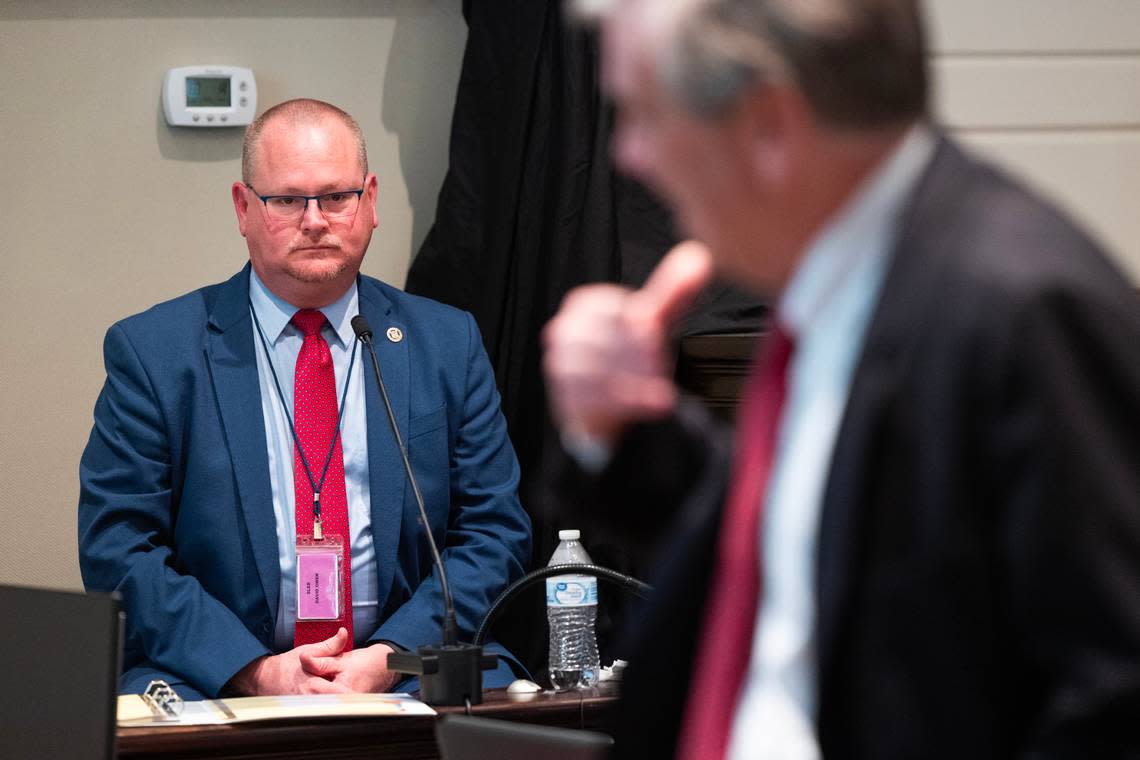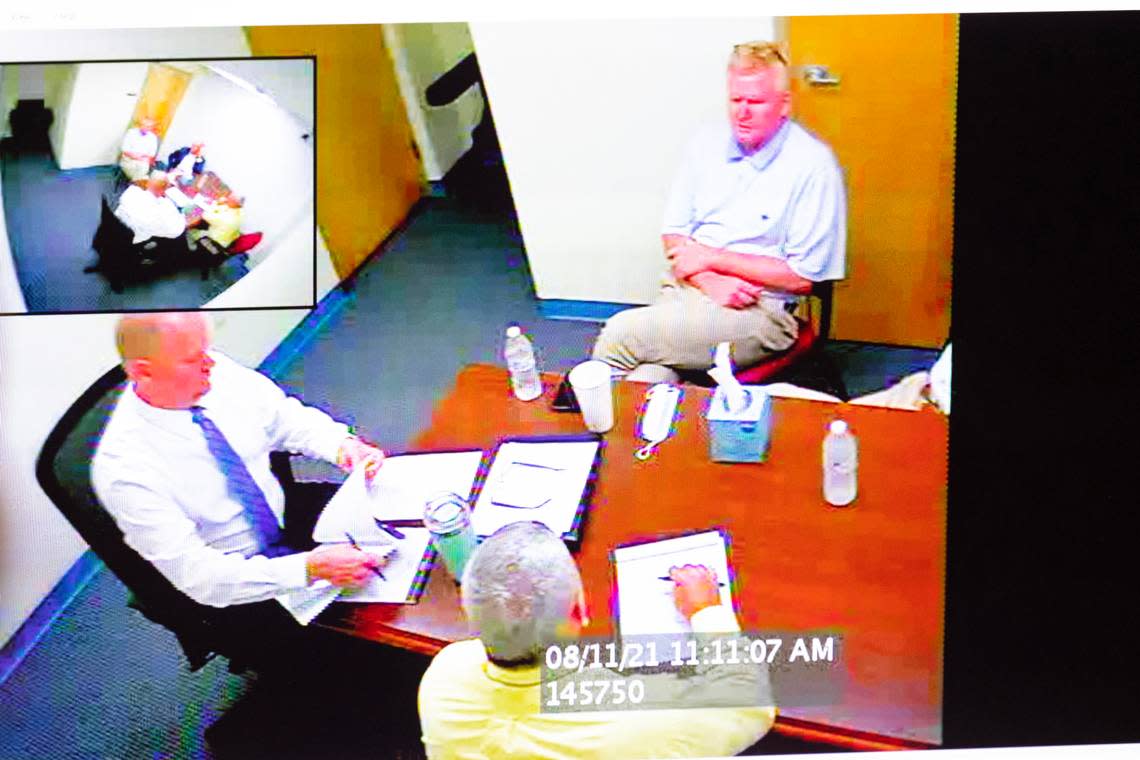Murdaugh trial jury to hear new evidence about roadside shooting, Curtis Smith
Jurors at Alex Murdaugh’s double-murder trial were expected Thursday to hear Murdaugh admit he lied about an attempted suicide scheme that sent him to the hospital with a gunshot wound over Labor Day weekend 2021.
Attorneys for the prosecution and defense delayed the start of proceedings Thursday to hammer out how much of a 41-minute interview Murdaugh gave to investigators from the hospital in September 2021 can now be played for the jurors. On the tape, Murdaugh is expected to confess he initially lied about the shooting to investigators.
A surprise ruling to close out the day Wednesday opened up new avenues to talk about a man jurors have heard little about — Murdaugh’s distant cousin and accused Labor Day weekend shooter Curtis “Eddie” Smith — and a lie Murdaugh admitted he told investigators after the June 7, 2021, murders of his wife Maggie, and youngest son, Paul.
“The defense went right there as though they could dance through fire without getting burned,” Judge Clifton Newman said Thursday.
Murdaugh initially told investigators he was shot on the side of a rural Hampton County road on Labor Day weekend 2021. He said he was attacked by a stranger after he stopped to change a tire, leaving him with a small head wound that left him hospitalized.
But that story quickly collapsed, and Murdaugh admitted that he had asked Smith to shoot him, a day after Murdaugh was fired from his family’s law firm for allegedly stealing millions of dollars from his law partners and clients. He hoped his surviving son, Buster, would receive a $10 million life insurance payout after his death, but believed a suicide would negate the payout.
Newman first ruled against the state admitting any more evidence about the shooting, calling it a “bridge too far” that was not obviously related to Paul and Maggie’s murders. But hours later, the judge reversed himself after defense attorney Jim Griffin questioned the S.C. Law Enforcement Division’s lead case investigator about Smith and his alleged debts to a drug gang called the Cowboys.
Prosecutor John Meadors then used that as an opening to ask investigator David Owen questions about Smith’s role in the roadside shooting, over the objections of the defense table.
Jurors first heard on Tuesday about the Labor Day weekend shooting, when Maggie’s sister, Marian Proctor, testified that she initially believed the shooting was related to her sister and nephew’s killings, causing her to fear for her family’s safety. But her assessment changed after Murdaugh admitted he lied about the incident, Proctor testified.
Newman already ruled to admit testimony from many witnesses about Murdaugh’s alleged thefts from partners at the law firm founded more than 100 years ago by his great-grandfather, as well as several clients whose settlement money he was supposed to safeguard, many of them children injured in car accidents. Murdaugh has yet to be tried for those crimes, and his attorneys have argued they are irrelevant to the question of who killed Maggie and Paul.

Murdaugh’s third interview
The breakthrough on the Smith evidence came during lengthy testimony from Owen, SLED’s lead investigator on the murder case.
A centerpiece of Owen’s testimony was a video recording from Aug. 11, 2021, two months after Maggie and Paul were killed, and weeks before Murdaugh allegedly attempted suicide. It was the third time Murdaugh had sat for a formal interview with SLED.
Murdaugh brought a longtime friend and Beaufort lawyer, Cory Fleming, with him. SLED agent Jeff Croft also attended, repeatedly probing Murdaugh’s whereabouts the day of the murders.
Midway through the interview, Owen asked Murdaugh to confirm that he was not, as he had told them twice already, at the kennels between dinner and when he returned from visiting his mother the night of June 7, 2021.
“Yes sir,” Murdaugh replied, confirming that he was not at the kennels.
Under defense attorney Griffin’s questioning, Owen also admitted that he had deliberately deceived Murdaugh about evidence recovered from the murder scene and mischaracterized that same evidence to a Colleton County grand jury.
“Would you agree that was an opportunity missed?” Griffin asked Owen, stressing that Murdaugh had said he was at his parents’ house 15 miles away when his wife and son were killed. If he were the killer, couldn’t Murdaugh have hidden the weapons — a shotgun and an assault rifle — on their property, Griffin asked.
It was “probably missed,” Owen replied tensely.
Owen also admitted that he testified to a Colleton County grand jury that Murdaugh’s shirt contained multiple areas of blood spatter. This was despite a HemaTrace test, which tests for the presence of human blood, coming back negative. Owen said that while the report was in his email, he did not know about it until November 2022, after he testified before the grand jury.
“I did not see that report,” Owen said. “I was not made aware of its existence.”
Referencing a June 8, 2021, conversation he had with Paul’s friend Rogan Gibson, Owen said Gibson had said Murdaugh’s voice could be heard in the background of a call Paul made from the kennels before 9 p.m.
“Rogan Gibson had asked me if I was up there, that he thought it was me,” Murdaugh told Owen.
Asked directly if he had been at the kennels that night, Murdaugh responded, “At 9 o’clock? No sir, not if my times are right.” Then who did Murdaugh think Gibson heard on the phone, Owen asked. “I have no idea,” Murdaugh said.
Owen also pressed Murdaugh about the family’s guns, including where they were kept, if any were missing and what ammunition was loaded in them. A gun taken from the gun rack had both bird shot and buck shot in it, the same load that killed Paul, Owen said. Murdaugh told Owen that he wouldn’t normally load multiple kinds of shot.
Alsl on cross-examination, Owen was confronted by Griffin, who said that no shotguns with both bird shot and buck shot had been recovered from the home.
“I’m allowed to use trickery to elicit a response,” Owen told Griffin.
Owen later admitted he had told a Colleton County grand jury that he had found guns loaded with both buck shot and bird shot.
Griffin accused Owen of focusing on Murdaugh to the exclusion of all other potential suspects, among them Curtis “Eddie” Smith, who Griffin said was skimming money from the $50,000-a-week Murdaugh paid him for drugs. Owen said he was unaware of Smith doing that.
Griffin also argued that Owen failed to follow up on evidence, such as DNA found under Maggie’s fingernails that belonged to an unidentified male.

Murdaugh asked if he was the main suspect
During that Aug. 11, 2021, interview, Fleming — Murdaugh’s friend and attorney — questioned whether SLED was considering Murdaugh as a suspect in the case.
“I’m uncomfortable with you asking him questions as a suspect because I came here with the thought you were going to be telling him where you are in the investigation,” Fleming is heard saying in the video.
In the video, Owen says the purpose of the interview is to further their investigation, and that he had previously explained to Murdaugh, “any homicide investigation starts with the closest person, or the person who found the deceased.”
Throughout the interview, Murdaugh repeatedly emphasized that he wanted to cooperate and asked investigators if they would share information with Maggie’s family.
Asked directly if he killed his wife and son, Murdaugh said no. Asked if he knew who did, Murdaugh again said no.
“Do you think I killed Paul?” Murdaugh asked. “Do you think I killed Maggie?”
“I have to go where the evidence and the facts take me,” Owen replied. “And I don’t have anything that points to anybody else at this time.”
Owen asked Murdaugh when he changed clothes from the outfit he was seen wearing in a Snapchat video Paul shot earlier in the day.
“I’m not sure. What time of day was that?” Murdaugh asked.
When told the video might have been shot about 7 or 8 p.m., Murdaugh said he must have changed when he got back to the house.
SLED agents also asked Murdaugh about why Maggie did not go with him to visit his mother, Libby, that night. Maggie’s sister, Proctor, testified that was the main reason Maggie had gone back to the house that night from the Murdaughs’ Edisto beach house, where she preferred to stay.
“I don’t remember if she planned to ride with me,” Murdaugh said. “Maybe she told me that. I don’t recall that specifically. She didn’t normally go over there.”
Murdaugh told investigators he was at his mother’s house for 45 minutes to an hour.
On the stand, Owen confirmed that by this point, he had already spoken to Murdaugh’s mother’s caregiver, Mushelle “Shelly” Smith, who earlier testified Murdaugh had only been in the house for 15 to 20 minutes.
At the end of the interview, an emotional Murdaugh asked Owen, “I would like to know exactly what happened.”
“Me too,” Owen replied.
Later on Thursday, investigator Kenny Kensey testified to blood spatter evidence from the shooting scene, indicating where the shooter was during the killings of Paul and Maggie. One new piece of evidence from his testimony was that a mark on Maggie’s calf was tied to the tire tread of a nearby vehicle, although Kensey could not say if that meant Maggie’s body was actually run over by the vehicle.
Kinsey was also asked about swabbing the Murdaugh house for DNA evidence the night of the shooting, but Kinsey said there was so much family DNA there it would not have been very helpful.
Reporters Ted Clifford and John Monk contributed to this report.
